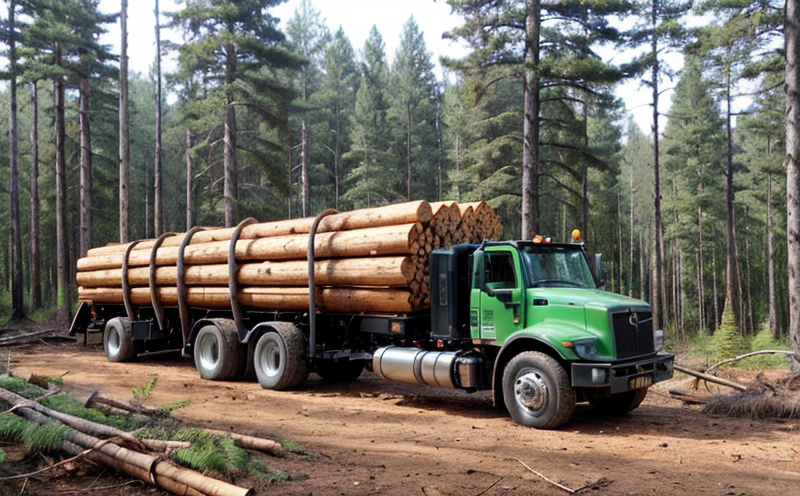Timber Flammability Testing
In the realm of forestry products testing, timber flammability is a critical aspect that ensures both safety and compliance. Timber used in various applications such as construction, furniture, and flooring must meet stringent fire safety standards to protect consumers and prevent potential hazards.
Flammability tests assess how quickly or slowly a material ignites, burns, and extinguishes under specific conditions. These tests are not just about assessing the risk of ignition; they also determine the rate at which the material will burn once ignited. The results of these tests help in understanding the combustibility behavior of timber products, which is essential for ensuring fire safety.
Timber flammability testing typically involves exposing a sample to controlled heat sources and measuring various parameters such as the time it takes for ignition, flame spread rate, smoke production, and residual mass after combustion. The standard test methods used include ISO 5660-2:2018, which specifies the apparatus and procedures for determining the flammability of materials by means of vertical flame propagation.
Understanding the specific requirements of timber products is crucial before conducting these tests. Factors such as the type of timber (e.g., softwood vs. hardwood), its intended use, and environmental conditions like humidity and temperature can influence the results. Proper specimen preparation is also vital; this includes ensuring that samples are representative of the material being tested, cut to specified dimensions, and conditioned according to the relevant standards.
The testing apparatus used in these evaluations often consists of a vertical furnace or tunnel furnace, where specimens are exposed to controlled conditions of temperature and airflow. The performance is then measured by observing how the flame behaves on the specimen surface, noting any changes in appearance, and recording data such as the time until ignition and the duration of the flame.
The results from timber flammability tests provide valuable insights into a product's fire resistance capabilities. Compliance with appropriate standards ensures that products can be used safely without posing undue risks to users or environments. Regulatory bodies often mandate these tests, making them an indispensable part of quality assurance processes for manufacturers and suppliers.
Industry Applications
| Application Sector | Specific Use Cases |
|---|---|
| Agriculture & Forestry | Testing of wooden structures in agricultural buildings, silos, and storage facilities. |
| Built Environment | Evaluation of flooring materials for residential and commercial spaces. |
| Furniture Manufacturing | Determining the flammability characteristics of wooden furniture components. |
- Testing wood used in agricultural structures to ensure compliance with fire safety codes.
- Evaluating the fire resistance properties of timber in residential buildings for better safety measures.
- Assessing the flammability characteristics of wooden components in furniture to enhance consumer protection.
Quality and Reliability Assurance
Timber flammability testing is a cornerstone of quality assurance processes in forestry products. It ensures that timber used across various sectors meets the highest standards for safety, performance, and reliability. By conducting these tests, manufacturers can demonstrate their commitment to producing safe and reliable products.
The process begins with careful selection of representative samples from different batches or production runs. These samples are then prepared according to specified dimensions and conditioned under controlled environmental conditions to ensure consistent results. Once ready, the specimens are subjected to standardized flame exposure tests in a vertical furnace or tunnel system.
During testing, critical parameters such as ignition time, flame spread rate, smoke density, and residual mass after combustion are meticulously recorded. These data points provide comprehensive information about the material's combustibility behavior under controlled conditions. The results are compared against established standards to determine compliance levels.
The reliability of these tests is paramount in ensuring that timber products perform consistently across different environments and applications. By adhering strictly to international standards like ISO 5660-2:2018, laboratories can maintain high levels of accuracy and repeatability. This consistency builds trust among stakeholders, including manufacturers, regulatory bodies, and end-users.
Furthermore, the results from these tests are used by quality managers to make informed decisions about product improvements or adjustments in manufacturing processes. They also serve as valuable data points for compliance officers during audits and inspections, ensuring that all products meet stringent safety regulations.
Customer Impact and Satisfaction
- Enhanced Safety: Timber flammability testing ensures that products are safe to use in various environments, reducing the risk of fire hazards.
- Increased Reliability: By meeting strict standards, products perform consistently across different conditions, improving customer satisfaction.
- Better Decision-Making: Testing provides valuable data for quality managers and R&D engineers, enabling them to make informed choices about product development and improvement.
Customers in the agriculture & forestry sector benefit significantly from reliable timber flammability testing. For instance, farmers can use tested wooden structures with confidence, knowing they are safe against fire risks. Similarly, furniture manufacturers can ensure that their products meet strict safety standards, thereby enhancing brand reputation and customer trust.
Testing also impacts procurement processes by providing objective data for decision-making. Procurement officers can rely on the results of these tests to choose suppliers who adhere to high quality and safety standards. This not only ensures product reliability but also fosters long-term partnerships with trusted vendors.





